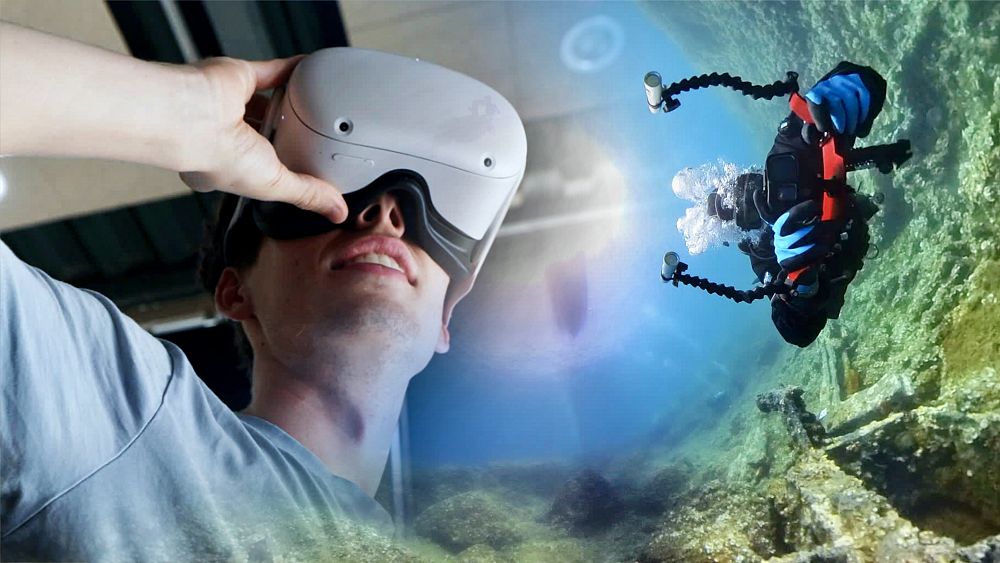
From 3D models to virtual reality headsets and android robots, Ocean takes a deep dive into European projects using technology to forge a stronger connection between the public and our underwater cultural heritage.
A team of researchers, led by Fabio Bruno from the University of Calabria, is on a mission to unveil these hidden treasures.
“Not everyone can access underwater cultural heritage as it requires diving to see it,” Fabio Bruno explained. “To make this immense heritage known to the general public, it is crucial to use multimedia technologies that enable visitors to explore these sites and comprehend their significance.”
We join the team of the European project CREAMARE as they embark on their mission at one of Italy’s most significant shipwrecks.
The team includes archaeologists, historians, and specialists in computer technology, determined to make the underwater archaeological site beneath our boat accessible to everyone through a highly detailed 3D model.
Our dive uncovers the remains of ‘Lombardo,’ a 19th-century steamship used by the legendary Giuseppe Garibaldi.
The vessel, which played a crucial role in the Risorgimento movement, sank and was lost over 160 years ago. It wasn’t until the early 2000s that Italian archaeologists stumbled upon these historic remains.
The project team is creating a digital snapshot of the entire site.
“Digitising and creating a three-dimensional model of this wreck will enable those who cannot dive, who aren’t able to go underwater, to experience a virtual dive similar to that of real divers,” said Salvatore Medaglia, an archaeologist at the University of Calabria.
The researchers employ the method of photogrammetry, capturing a series of still shots using a relatively affordable camera enclosed in an underwater case. These photographs serve as the material for generating a detailed 3D model, offering an immersive and interactive experience.
The goal is to find the most accessible tools and techniques so that underwater archaeologists could be trained to create such models themselves, without assistance from computer engineers.
Engaging future generations to preserve underwater treasures
Europe’s underwater heritage is rich and diverse — from ancient wrecks laden with precious cargo to submerged cities. But it’s often hard to access and remains largely unseen.
Researchers believe that virtual reality devices will soon become more commonplace. This technology can help build a stronger connection between the public and the underwater heritage, highlighting the need to preserve it for generations to come.
“Our goal is to enable the development of multimedia applications that allow the general public to both learn about underwater cultural heritage and to more deeply understand the environmental challenges affecting our seas,” Fabio Bruno told Ocean.
Museums are increasingly using new technologies to enhance their exhibitions. In Taranto, a coastal city in Southern Italy, we visit the National Superintendency for Underwater Cultural Heritage, led by the esteemed archaeologist Barbara Davidde.
Its new collection of Corinthian pottery dating back to the 7th century B.C. was discovered 780 meters deep in the Adriatic during the construction of a gas pipeline. These priceless artefacts are safeguarded behind protective glass, but a large interactive screen nearby allows visitors to examine detailed photogrammetric models from every angle.
“The visitor can zoom into the 3D shape of the object, to see in detail the execution technique and the biological organisms that colonised the artefacts during their time on the seabed,” revealed Barbara Davidde.
In addition, the exhibition features a so-called ‘serious game’ — a simulation of an archaeological excavation in virtual reality.
“When you have the practical experience of underwater exploration, even a virtual one, you derive more pleasure from your visit, and you better remember what you saw and what you learned,” Barabara added.
Malta: Using technology to boost eco-tourism
Such immersive experiences can even help promote more eco-friendly tourism. In Malta, like many other coastal regions, tourists flock to bustling high-rise hotels, cruise ships, and vibrant urban nightlife — often missing out on the wonders of untouched natural beauty.
Many visit historic monuments, like the 5000 years old Ħaġar Qim megalithic temples. That’s an opportunity for CORALLO, the European project spearheaded by Malta’s Ocean Ambassador, Professor Alan Deidun.
Android robots, virtual reality headsets, and other interactive tools are strategically placed at visitor centres — to spark tourists’ interest in local marine biodiversity and ecotourism.
“You might have gone on a Mediterranean holiday just for the history, just for the culture. But then you manage to squeeze in that snorkelling trip, a kayaking trip,” Alan Deidun told Ocean.
The project works with local groups that organise eco-friendly sea activities at protected natural sites, looking for the best ways to connect them with tourists. ‘Get Out and Kayak’ is one of the project partners.
“We believe in eco-tourism, eco-sport,” said ‘Get Out and Kayak Malta’ co-founder, Arthur “Turu” Quintano.
“We want as many people on the sea as possible, with as little to no carbon footprint whatsoever. So for us, it’s important that we teach people how to respect the sea, how to care for the sea.”
Ecotourism opens up unique views which are inaccessible to others.
“Tourists come to Malta because we do have beautiful scenery. There are loads of caves that we can go in and explore,” revealed fellow ‘Get Out and Kayak Malta’ co-founder Daniela “Lella” Bonavia.
This way, tourists can be a part of the solution, not the problem.
“This sort of renaissance of awareness about the environment couldn’t come soon enough,” said Alan Deidun.
“More than half of the Mediterranean coastline is under concrete already. We need to change course to try to save as much as possible of the remaining pristine areas,” he concluded.